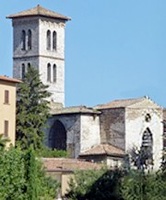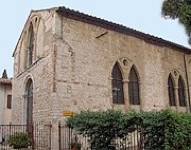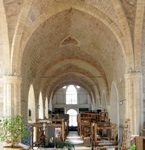


According to tradition, St Francis established the first Franciscan community here in 1212; whether or not that is correct, a church here dedicated to St Francis that belonged to a Franciscan community was documented here in 1236. This community moved to San Francesco al Prato in 1253.
Establishment of the Nunnery
In 1248, a lady called Benvenuta di Cilino di Assisi made bequests to a number of nunneries in Perugia:
-
✴Santa Caterina (later Santa Caterina Vecchia);
-
✴Santa Maria di Monteluce; and
-
✴Sant’ Angelo di Arenaria (or del Renaio), near Cenerente (some 4 km outside Porta Sant' Angelo).
This last (Benedictine) community bought this site from the Franciscans in 1253, and their nunnery became known as San Francesco delle Donne.
Its security increased dramatically in 1327 when it was included inside the new circuit of city walls. It absorbed a series of communities from nunneries outside the walls throughout the 14th and 15th centuries.
Later History
In 1547, Cardinal Tiberio Crispo sponsored the refurbishment of the church and nunnery. The nuns sold land on what became the site of the Monastero di Santa Caterina Nuova to the nuns of Santa Giuliana to raise further funds for this project.
The nearby Monastero di Santa Caterina Vecchia was open to attack during the siege by Tuscan soldiers in the War of Castro (1643), and the nuns there moved to Sant Francesco delle Donne for a short period.
The nuns managed to return after the first Napoleonic suppression, but their community was suppressed definitively in 1815. The complex was devoted to the education of poor girls for a period thereafter. It now houses co-operative founded by Giuditta Brozzetti in 1921, which is dedicated to maintaining an old tradition of fabric production.
Architecture of the Church


The church is in the form of a Latin cross with a single nave. Its nucleus seems to have been an earlier, centrally-planned church that was later developed as the transept of the current structure.
The best-preserved parts of the original structure include: the vaults of the crossing, which are supported by clustered columns with lovely capitals; the portal; and the campanile. The windows along the nave and those in the transepts and in the apse were opened in the neo-Gothic restoration of the late 19th century.
The church was further restored in 1938-43. Traces of frescoes that covered the walls were found under the plaster, but these are illegible.
Art from the Church
Madonna and Child with donor (1492)
The inscription at the base of this panel reveals that it was commissioned by a Benedictine nun, Giacoma di Baldo Perigli as an ex voto offering. It is sometimes attributed to Bernardino di Mariotto, but has more recently been attributed to his teacher, Ludovico di Angelo. It was transferred from San Francesco delle Donne to the Accademia di Belle Arti in 1810 and is now in the deposit of the Galleria Nazionale.
The panel depicts the Madonna and Child, with a nun kneeling to the left. She must be Sister Giacoma di Baldo Perigli, who was presumably a member of the community at San Francesco delle Donne.
Madonna and Child with Saints (16th century)
This panel, which is attributed to Bernardino di Mariotto, passed from San Francesco delle Donne to the Accademia di Belle Arti in 1810 and is now in the deposit of the Galleria Nazionale. It depicts the Madonna and Child with the young St John the Baptist and SS Benedict and Francis.

